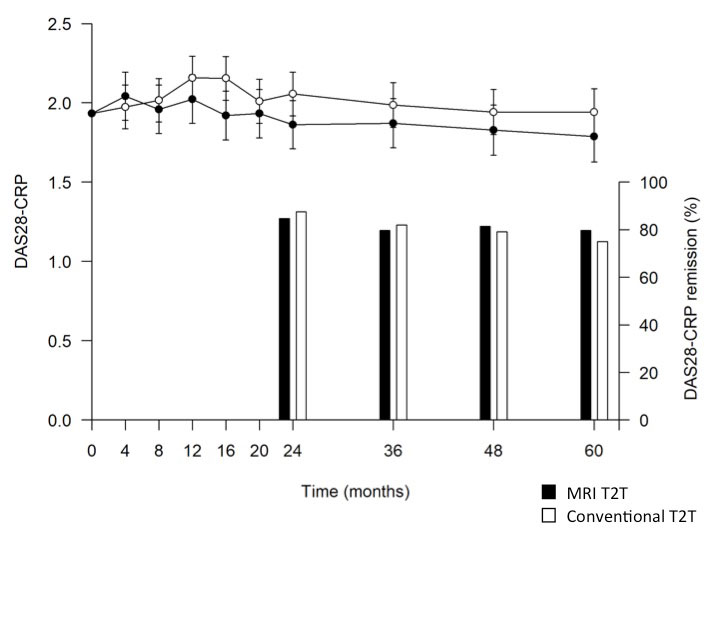Session Information
Session Type: Poster Session B
Session Time: 9:00AM-10:30AM
Background/Purpose: Targeting MRI remission in rheumatoid arthritis (RA) patients in clinical remission may improve long term clinical, functional and MRI outcomes. The purpose of the IMAGINE-MORE study was to investigate whether a 2-year MRI treat-to-target (T2T) strategy, based on structured MRI assessments targeting absence of osteitis combined with clinical remission, compared with a conventional clinical T2T strategy targeting clinical remission only, improves disease activity, physical function and suppresses MRI-inflammation over 5 years in RA patients.
Methods: The IMAGINE-MORE trial was designed as an extension protocol to the 2-year, IMAGINE-RA randomized trial. IMAGINE-RA included 200 RA patients in clinical remission (DAS28-CRP< 3.2 AND no swollen joints) who received conventional synthetic disease-modifying antirheumatic drugs (csDMARD) and investigated whether an MRI T2T strategy targeting absence of osteitis in combination with clinical remission (DAS28-CRP≤3.2 and no swollen joints) could increase remission rates and prevent erosive progression compared with a conventional T2T strategy targeting clinical remission only. If treatment target was not met, treatment was escalated according to a predefined treatment algorithm starting with increment in csDMARDs and then adding biologics. At the end of the study, participants were invited to participate in the IMAGINE-MORE follow-up study and informed consent was obtained. Patients were managed in routine outpatient clinic applying a conventional treatment strategy targeting clinical remission. Protocolized clinical visits (year 3, 4 and 5) and contrast-enhanced MRI of the dominant hand 2nd-5th metacarpophalangeal joints (year 3 and 5) were carried out. The primary clinical endpoint was the proportion of patients achieving DAS28-CRP remission (DAS28-CRP< 2.6) at year 5. Predefined key secondary outcomes were disease activity (DAS28-CRP), and changes in MRI osteitis (OMERACT RA MRI scoring system (RAMRIS)) and functional level (HAQ) from baseline to 5 years follow up. Endpoints were analysed by logistic regression models (dichotomous endpoints) and repeated measures mixed effects models (continuous outcomes) adjusted for propensity scores corresponding to (remaining in) group allocation.
Results: Fifty-nine patients in the MRI T2T arm and 72 patients in conventional T2T arm consented to participate. Of these, 47 patients (80%) in the MRI T2T group and 54 patients (75%) in the conventional T2T group reached the primary clinical endpoint (OR= 2.00 [95%CI: 0.76 to 5.28]) (Table and Figure). No statistically significant differences between treatment strategies in the primary and key secondary outcomes were seen.
Conclusion: A two-year MRI T2T strategy targeting absence of MRI osteitis combined with clinical remission as compared to a conventional clinical T2T strategy in RA patients in clinical remission had no effect on the long-term probability of achieving DAS28-CRP remission. In accordance with the primary results from IMAGINE-RA trial, these long-term data do not support the use of an MRI-guided strategy for treating patients with RA in clinical remission.
Ref: Møller-Bisgaard S et al: JAMA 2019, 321(5):461-472.
To cite this abstract in AMA style:
Møller-Bisgaard S, Hørslev-Petersen K, Glinatsi D, Ejbjerg B, Hetland M, Møllenbach Møller J, Christensen R, Nielsen S, Boesen M, Stengaard-Pedersen K, Rintek Madsen O, Jensen B, Alexander Villadsen J, Hauge E, Hendricks O, Lindegaard H, Krogh N, Jurik A, Thomsen H, Østergaard M. Long Term Efficacy of a 2-year MRI Treat-to-target Treatment Strategy on Disease Activity, MRI Inflammation and Physical Function in Rheumatoid Arthritis Patients in Clinical Remission: Five Year Follow-up of the IMAGINE-RA Cohort [abstract]. Arthritis Rheumatol. 2022; 74 (suppl 9). https://acrabstracts.org/abstract/long-term-efficacy-of-a-2-year-mri-treat-to-target-treatment-strategy-on-disease-activity-mri-inflammation-and-physical-function-in-rheumatoid-arthritis-patients-in-clinical-remission-five-year-foll/. Accessed .« Back to ACR Convergence 2022
ACR Meeting Abstracts - https://acrabstracts.org/abstract/long-term-efficacy-of-a-2-year-mri-treat-to-target-treatment-strategy-on-disease-activity-mri-inflammation-and-physical-function-in-rheumatoid-arthritis-patients-in-clinical-remission-five-year-foll/


